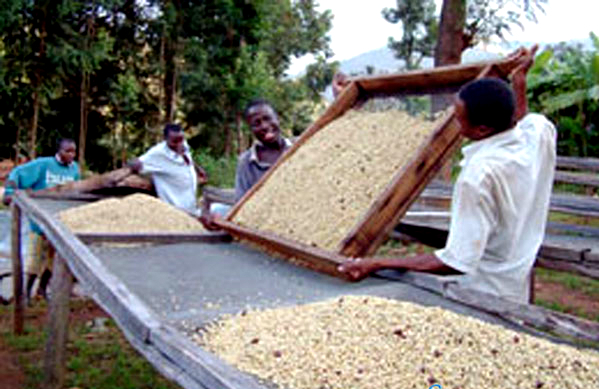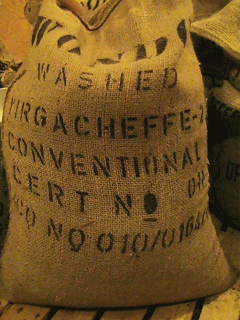Introduction to the main points of the knowledge of raw coffee beans: a detailed explanation of the classification of raw coffee beans
The final step in the processing of green coffee beans is the rating, so what are the rating methods for green coffee beans? Do different countries do the same thing?
At present, there are three main grading standards for green coffee beans, and different countries adopt different grading methods according to their own production status and national conditions (not all coffee producing countries adopt one method). Here are three popular rating methods.
I: Classification according to altitude of coffee producing area
The reason for this classification standard is mainly because the quality of coffee produced at high altitudes is generally higher than that produced at low altitudes, because high altitudes and low temperatures, slow coffee production is conducive to the accumulation of good substances. Moreover, the raw beans with high maturity have good expansion during baking, which is beneficial to baking and has more stable quality.
At present, coffee producing countries that adopt this classification standard include Guatemala, Mexico, Honduras, El Salvador and other Central and South American countries. In Guatemala, for example, the highest quality coffee is called SHB (Strictly Hard Bean), grown above 1350m, followed by HB (Hard Bean) hard beans, planted at 1200m--1400 m, and SH (Semi Hard Bean) Slightly Hard Bean, EPW (Extra Prime Washed) extra good washed beans, PW(Prime Washed) extra good washed beans, GW(Good Washed) good washed beans, planted at altitudes of 1200m, 1000m, 800m, 600m--800 m, 600 m or less.
II: Classified according to sieve
The method of sieve classification is the method of classifying coffee green beans according to their size. Raw beans are passed through a perforated iron sieve to determine the size of the beans and thus the grade. The hole size of the screen is 1/64 inch (less than 0.4mm), so the number of screens indicates that there are several 1/64 inches, such as the size of the 17th screen is 17/64 inches, about 6.75mm, so the larger the number of screens indicates the larger the particles of coffee beans.
The reason for this classification is that larger beans sell better and produce more varied flavors than smaller beans. However, it is not that the beans with large particles must be of better quality than the beans with small particles. Ethiopian coffee beans are generally narrow and small, but their taste is the most unforgettable and favorite, including Yunnan's small coffee, which is highly evaluated in the international market.
Kenya is one of the most representative countries classified according to the sieve, others include Tanzania, Colombia, etc.(some countries use more than one classification method, and the examples given here are representative of countries dominated by this method). Kenya's highest AA++ requires a sieve of 18 or more, which means that the bean size exceeds 7.15mm. Kenyan beans are carefully graded to include AA++, AA+, AA, AB, etc. Colombia has a simpler classification, divided into Supremo and Excelso according to bean size. 80% of the special grade raw beans need to use more than 17 mesh screens, 80% of the upper grade raw beans need to use more than 14/16 mesh screens, and at most 11% of the 14 mesh beans are allowed in the 16 mesh beans.
The screen mentioned above is for flat beans, round beans (Pea Berry) have their own set of screen size standards. Usually round beans are graded using a sieve of 8- 12.
III: Grading according to the proportion of sieve and defective beans
Defective beans are an important factor in spoiling the flavor of the final coffee. Therefore, defective beans should also be removed in the final step of green bean processing. This has the problem of how many defective beans, so according to the proportion of defective beans, supplemented by the size of the screen as a classification method.
Due to the rise of the fine coffee trend, coffee producing countries are increasingly paying attention to the quality of coffee, and controlling defective beans is the most important way, so basically using the proportion of defective beans as a grading method or auxiliary basis is becoming more and more common.
At present, Jamaica, Brazil and Ethiopia are the main representative countries that adopt defective bean proportion method. Jamaica takes the production area, altitude, sieve and defective bean proportion as the comprehensive rating standard. For example, Jamaica Blue Mountain NO.1 refers to the top coffee beans with the highest defective bean proportion of 2% in the Blue Mountain production area above 1700m with sieve No.18/17. The proportion of defective beans is used as an important basis. Jamaica strictly controls the proportion of defective beans, with a maximum of 4% of defective beans in each grade.
Brazil is another special country. Brazil is the world's largest coffee producing country, due to the large output, many origins, classification work is quite troublesome, and it is not suitable to adopt a single classification standard, so Brazil also adopts a variety of classification methods at the same time, defective bean ratio, screen, cup evaluation test are used in the Brazilian coffee bean classification process. The first two are needless to say, and the cup rating test is one of the characteristics of Brazilian coffee grading.
The so-called cup evaluation test is to evaluate the aroma and taste of coffee beans after roasting, grinding into powder and soaking them in hot water (about 90 degrees Celsius). There are 6 grades: Strictly Soft, Hard, Rio, Rioy. The first three grades can be uniformly called mild, the sour and sweet balance of coffee, and the taste is mild. The last three kinds are slightly worse in taste, especially the last two kinds are the worst. The reason why iodine smell appears is that the soil near Rio de Janeiro has a strong iodine smell. When coffee is harvested, it falls on the ground and absorbs soil odor.
(several kinds of defective beans)
The above three are now more popular coffee grading methods, but not all. Ethiopia, for example, will treat the way coffee beans are processed as one of the criteria for grading. In addition to this, there is an increasingly widely used COE rating system. As coffee producing countries pay more attention to coffee quality and producers are more motivated, the classification of coffee beans is not limited to the above three main methods. Only more careful cultivation can produce higher-quality coffee, in order to get a high rating in the rating, so coffee rating segmentation and strict control of coffee quality is undoubtedly a good thing.
Source:
Qingdao Xiumen Coffee Blog
Important Notice :
前街咖啡 FrontStreet Coffee has moved to new addredd:
FrontStreet Coffee Address: 315,Donghua East Road,GuangZhou
Tel:020 38364473
- Prev

Introduction to the treatment of raw coffee beans: classification and introduction of various refining methods of coffee beans
Generally speaking, there are three kinds of treatment from coffee fruit to raw coffee bean: drying treatment, washing treatment, semi-dry and semi-wet treatment. What is the difference between the three steps? Which is better or worse? (drying in the sun field) drying treatment is the most primitive and simple treatment. 1. After the coffee fruit is actually harvested, it is sent to the sun field to spread evenly, and it is often turned so that the coffee fruit can be evenly distributed.
- Next

Main points of knowledge about coffee raw beans: introduction to the trade of coffee raw beans and text analysis of sack packaging
Previous blog post: the hometown of coffee once introduced that the main production places of coffee in the world are concentrated in the narrow strip with the equator as the center line and latitudes within 25 degrees from north to south, like a belt around the earth, commonly known as the coffee belt (Coffee Belt). Among the more than 60 producing countries in the coffee belt, except for the local consumption in Brazil, the exports of other countries account for a large proportion of the total output.
Related
- Guji coffee producing area of Guji, Ethiopia: Humbela, Shakiso, Wulaga
- What is the most expensive variety of Qiloso in BOP multi-variety group?
- How to store the coffee beans bought home?
- Why are Yemeni coffee beans so rare now?
- Ethiopian Sidamo all Red Fruit Sun Sun Santa Vini Coffee beans
- SOE is mostly sour? What does it mean? Is it a single bean? what's the difference between it and Italian blending?
- Is Italian coffee beans suitable for making hand-brewed coffee?
- How to choose coffee beans when making cold coffee? What kind of coffee beans are suitable for making cold coffee?
- Just entered the pit to make coffee, what kind of coffee beans should be chosen?
- Can only Japan buy real Blue Mountain Coffee? What are authentic Jamaican Blue Mountain coffee beans?

